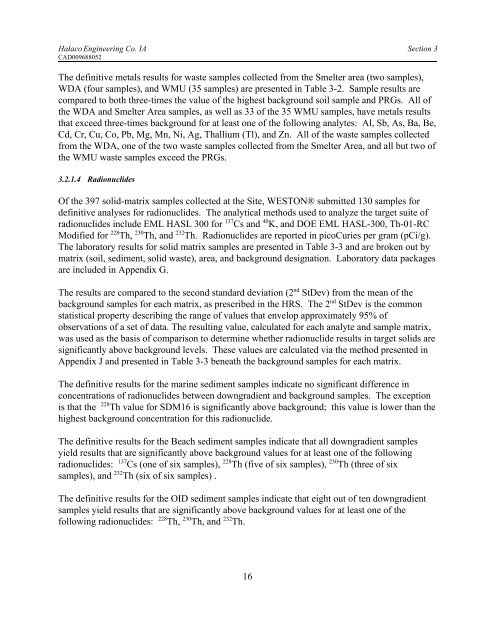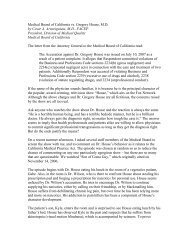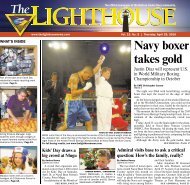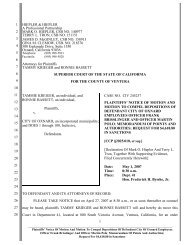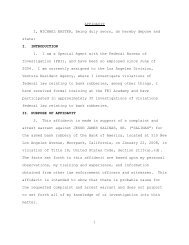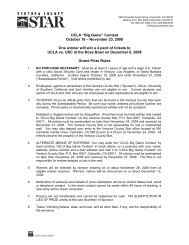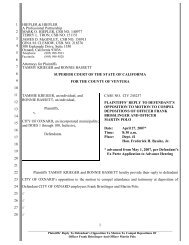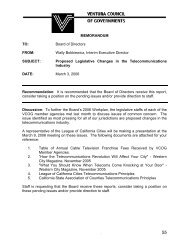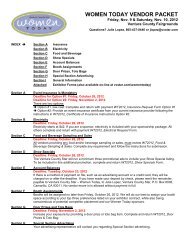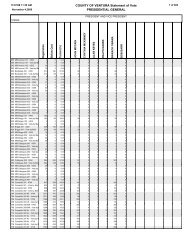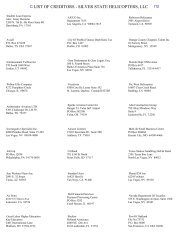Integrated Assessment Halaco Engineering Company ... - Archives
Integrated Assessment Halaco Engineering Company ... - Archives
Integrated Assessment Halaco Engineering Company ... - Archives
You also want an ePaper? Increase the reach of your titles
YUMPU automatically turns print PDFs into web optimized ePapers that Google loves.
<strong>Halaco</strong> <strong>Engineering</strong> Co. IA Section 3<br />
CAD009688052<br />
The definitive metals results for waste samples collected from the Smelter area (two samples),<br />
WDA (four samples), and WMU (35 samples) are presented in Table 3-2. Sample results are<br />
compared to both three-times the value of the highest background soil sample and PRGs. All of<br />
the WDA and Smelter Area samples, as well as 33 of the 35 WMU samples, have metals results<br />
that exceed three-times background for at least one of the following analytes: Al, Sb, As, Ba, Be,<br />
Cd, Cr, Cu, Co, Pb, Mg, Mn, Ni, Ag, Thallium (Tl), and Zn. All of the waste samples collected<br />
from the WDA, one of the two waste samples collected from the Smelter Area, and all but two of<br />
the WMU waste samples exceed the PRGs.<br />
3.2.1.4 Radionuclides<br />
Of the 397 solid-matrix samples collected at the Site, WESTON® submitted 130 samples for<br />
definitive analyses for radionuclides. The analytical methods used to analyze the target suite of<br />
radionuclides include EML HASL 300 for 137 Cs and 40 K, and DOE EML HASL-300, Th-01-RC<br />
Modified for 228 Th, 230 Th, and 232 Th. Radionuclides are reported in picoCuries per gram (pCi/g).<br />
The laboratory results for solid matrix samples are presented in Table 3-3 and are broken out by<br />
matrix (soil, sediment, solid waste), area, and background designation. Laboratory data packages<br />
are included in Appendix G.<br />
The results are compared to the second standard deviation (2 nd StDev) from the mean of the<br />
background samples for each matrix, as prescribed in the HRS. The 2 nd StDev is the common<br />
statistical property describing the range of values that envelop approximately 95% of<br />
observations of a set of data. The resulting value, calculated for each analyte and sample matrix,<br />
was used as the basis of comparison to determine whether radionuclide results in target solids are<br />
significantly above background levels. These values are calculated via the method presented in<br />
Appendix J and presented in Table 3-3 beneath the background samples for each matrix.<br />
The definitive results for the marine sediment samples indicate no significant difference in<br />
concentrations of radionuclides between downgradient and background samples. The exception<br />
is that the 228 Th value for SDM16 is significantly above background; this value is lower than the<br />
highest background concentration for this radionuclide.<br />
The definitive results for the Beach sediment samples indicate that all downgradient samples<br />
yield results that are significantly above background values for at least one of the following<br />
radionuclides: 137 Cs (one of six samples), 228 Th (five of six samples), 230 Th (three of six<br />
samples), and 232 Th (six of six samples) .<br />
The definitive results for the OID sediment samples indicate that eight out of ten downgradient<br />
samples yield results that are significantly above background values for at least one of the<br />
following radionuclides: 228 Th, 230 Th, and 232 Th.<br />
16


